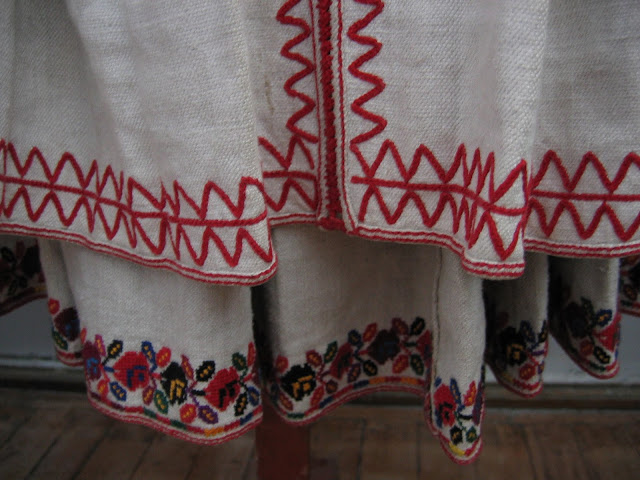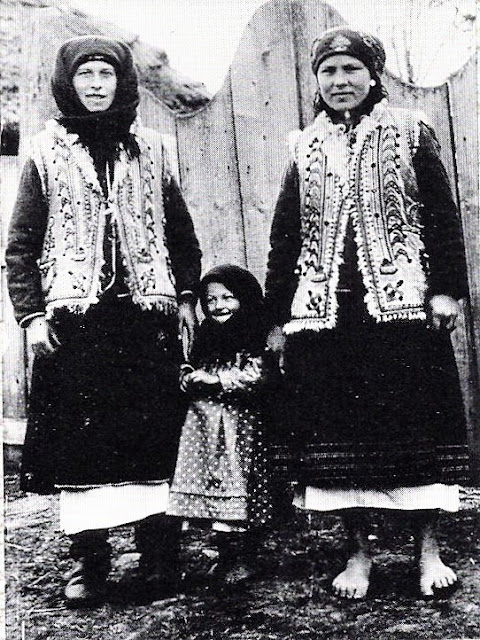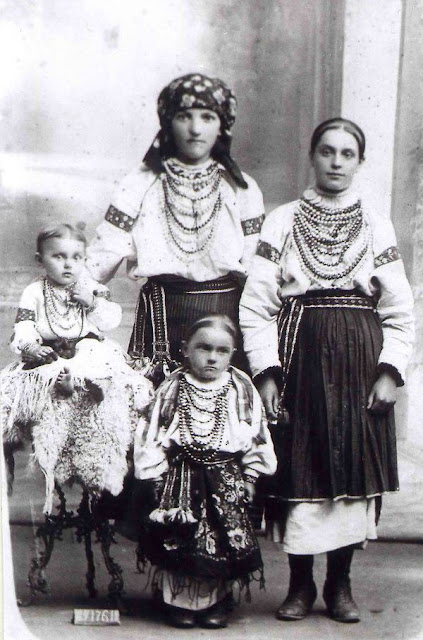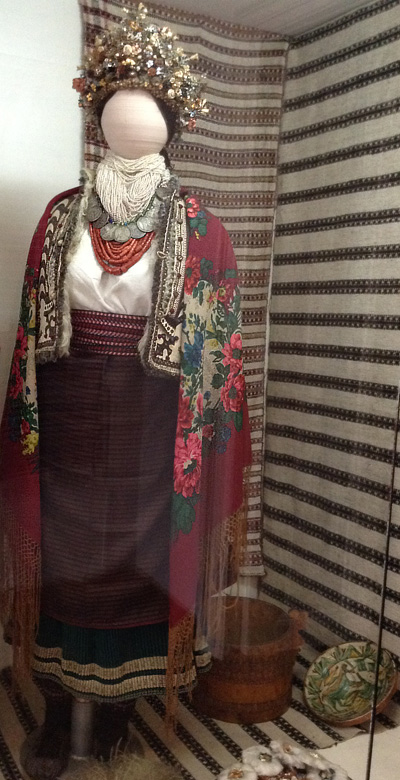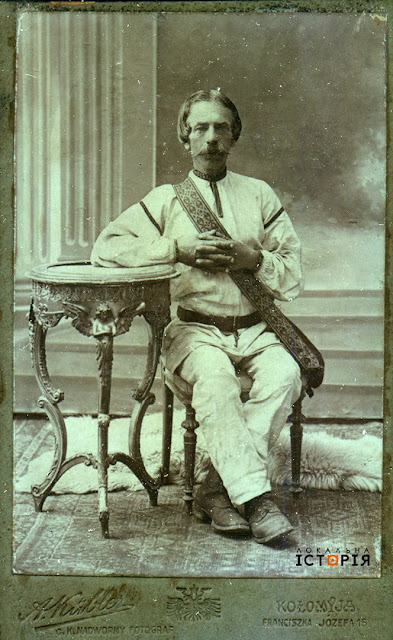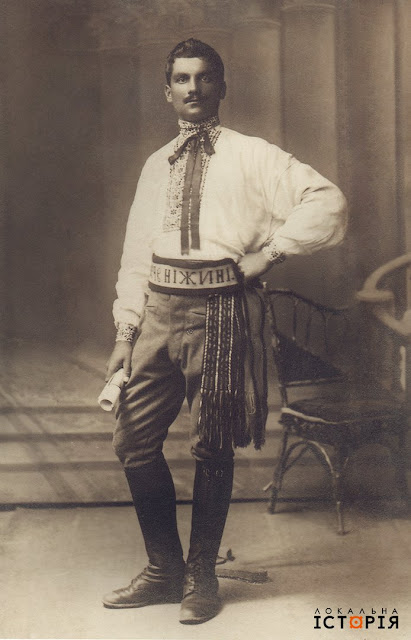Hello all,
I have written a few articles about Pokuttia, all talking about the costume and embroidery in the eastern part. Today I will try to talk about the costume of the region around the town of Kolomyja, in western Pokuttia, Ukraine. It is often thought that Kolomyja is Hutsul, but this is not the case. The Hutsul region lies to the south, in the highlands. Kolomyja lies on the Prut River lowlands. The culture of west Pokuttia does have much in common with Hutsul culture, however. The town gave its name to the famous dance and song style, kolomyjka, which is very popular not only with Hutsuls, but also Boikos, and even Lemkos and the Rusyns in Slovakia.
The image above is a very famous one, which is often seen. It is of a bridal couple from the village of Kornych, which lies just southeast of Kolomyja. It underscores one of the great costume traditions of the region, which is that of extremely elaborate bridal headdresses.
This costume appears in a famous woodcut by Sviatoslaw Hordynsky, along with the Posvicha costume.
I have reconstructed the costume based mostly on these old photographs. Luckily, there are a lot of them.
The base of the costume is the sorochka, or chemise, in ustawka cut. Some of the images I have found seem to show the ustawka set in vertically, as is done in dress shirts of west Podillia, Bukovyna and some parts of Hutsulshchyna. The main ornament is a single band of embroidery on the bottom edge of the ustawka, usually from 1 to 3 inches wide. The hem is not embroidered, the collar is not visible in any of my photographs, and the sleeves either have a wristband into which the sleeve is gathered, or the sleeve ends are left open, with minimal ornament. There is no embroidery on the sleeve itself. The embroidery is dense, usually with the entire ground covered, and the edges are either straight or gently scalloped. Sometimes the embroidery is nyzynka. Here is a modern photograph of the costume of Kornych village. Here is an embroidery design from Kornych village, drawn by Ivan Honchar himself.
Typical nyzynka design. Notice that the teeth on the edges are small, unlike what would be seen in Hutsul designs. And another example from Voskresyntsi village, also drawn by Ivan Honchar.
Other styles of embroidery were also used, some of them incorporating unusual stitches, like this example from Kornych village, from Maria Kalyniak's book. Here we see counted satin stitch, as is also seen in some Horodenka embroideries.
Many of the photographs seem to show floral cross stitch with a black or dark background, as is common in regions slightly further west. See this photo from Nyzhnij Verbizh village.
Here is a closeup of such a design, likely from the Dolyna Kalush area.
Geometrical or floral cross stitch designs with a white background are not unkown. Here is an example from Pechenizhyn village. She exceptionally has some embroidered motifs low on the sleeve, and no cuffband.
Here are some embroidery samples which are attributed to this area. The large 'rose' designs are also known from the Horodenka region.
I suspect that many of the photos of embroidery designs which have no information of origin attached may be assigned to this region. Here are a couple of examples.
The basic 'waist garment' was originally an obhortka [rectangular wrap around], if shorter than the ones used further east. Unlike regions further east, the front corner was rarely tucked up. I have only one photo that shows this, of a woman in an everyday work outfit from the village of Pidhaichyky.
Most commonly, both corners were left hanging, as in this photo, also from Pidhaichyky.
The garment was wrapped around the waist with soft folds, and held in place by a sash. The obhortka was usually arranged with the front edge hanging in the middle. This photo is from
Voskresyntsi village.
These two photos are from Kornych village. Note that the obhortyky have three pale stripes at the hem.
This one I do not know which village it is from. Note that in this photo, narrow vertical lines are visible on the obhortka.
In some photos, the obhortka is wrapped in such a way that it does not overlap, and an apron is worn over the gap, resembling the way a plakhta is worn. You can see that some of the aprons are pleated, and all have a woven sash tied around the waist over them. All the aprons are made of colored store bought cloth. In the first photo, she is wearing a length of Czech ribbon instead of a sash, and in the last photo, the aprons are made of colorful floral material.
In this last photo, from Kornych village, we see the bride in the center wearing a fringed shawl as an apron. This was the tradition in some of the villages.
The obhortka was later replaced by an actual skirt. One common form this took was often pleated, of a dark solid color, with three white or pale ribbons appliqued at the hem, reminiscent of the three stripes woven into the obhortka. This was usually worn with an apron.
Here are a couple of contemporary photos of a bride from the village of Velykij Kliuchiw, wearing contemporary embroidery on her chemise, but wearing this skirt in dark green with gold galloon. Notice that she is wearing a fringed shawl for an apron, as in the above example. The men are in standard contemporary Ukrainian embroidered shirts and pants, like you would find all over Ukraine.
Some of the aprons were made of floral printed or brocade material, and were wide, and often pleated, like the aprons. Here are a couple examples from the village of Pechenizhyn.
This woman is wearing a chemise that seems to have Poltava style embroidery. None of the other photos show embroidery like this.
Here is an example from the village of Nyzhnij Verbizh.
Another type of apron used was hand woven in one panel, usually with horizontal stripes. Here is an example, also from the village of Pechenizhyn.
More examples from the village of Voskresyntsi.
Another example from Kolomyja.
And a couple of exhibits at the Kolomyja Museum.
In other photos the apron is clearly of a floral design, but the skirt is not visible.
The upper body garment used in this region is the kyptar, made of sheepskin and resembling the type worn by Hutsuls. Mens' and womens' vests are identical, differing only in size.
They are highly ornamented with leather applique and other techniques. The most common form features strong, downturned tooth designs and 'rachky' [crawdads], here visible on the front sides of the man's vest. Let's take a look at the cover photo again.
These strong hooklike ornaments are diagnostic for the Kolomyja region. In other details, each was different, as each kyptar was made individually for a particular person by the local lymar.
You will see some that are quite plain, being intended for everyday use, and some villages have a unique design of their own.
If you peruse the various photos, you will see that all the women wore a great variety and number of necklaces, beads, patsiorky, gerdany, etc. The girls wore simple ribbon headbands, sometimes with loops of ribbons hanging behind the neck.
Married women wore kerchiefs. I am sure that a chepets of some sort was original to the costume, but I have been unable to document any.
The wedding headdresses of this region are justly famous, and vary from village to village.
Kornych
In this village, there were two types of wedding crowns. The first, worn by the bride was pointed at the top. The second type, which was very square, seems to have been worn by two bridesmaids.
This is one of the most elaborate of the wedding crowns and likely the most famous. It is distinguished not only by a wide variety of flashy colored elements, but most especially by the many white imitation flowers made from goose feathers. These are still being made and worn today, at least while the woman who makes them still lives. Note that in the recent photos the women are wearing generic contemporary Ukrainian embroidery on their blouses.
Men
The men's outfit is rather simple. White shirt, originally with little or no embroidery, white pants, sash or belt, shoulder bag, kyptar that is much like the woman's. Straw hat in summer, warm hat in winter. Boots. At a certain point, the white linen pants were replaced by riding jodhpurs of wool, under the influence of Austrian Army uniforms. Later even these were replaced by standard Ukrainian embroidered shirts and regular pants. Here are various images to add to those above.
I will close with a number of pictures of men and other images not included above.
Nyzhnyj Verbizh
Velykyj Kliuchiw
Kornych
Pechenizhyn
Note the little boy in the center, wearing only a long shirt and sash.
The Krovets collection has many good photos of individual garments from this area. They do not allow others to post them. Go and look at them if you are interested.
Thank you for reading, I hope that you have found this to be interesting and informative. There are so many local traditions like this one that have been lost. It is very lucky that there was a very active photographer in the town of Kolomyja. And for those who have beautiful photos or pieces of folk attire, please make known the point of origin for them if you decide to share them with the world.
Roman K
email: rkozakand@aol.com















